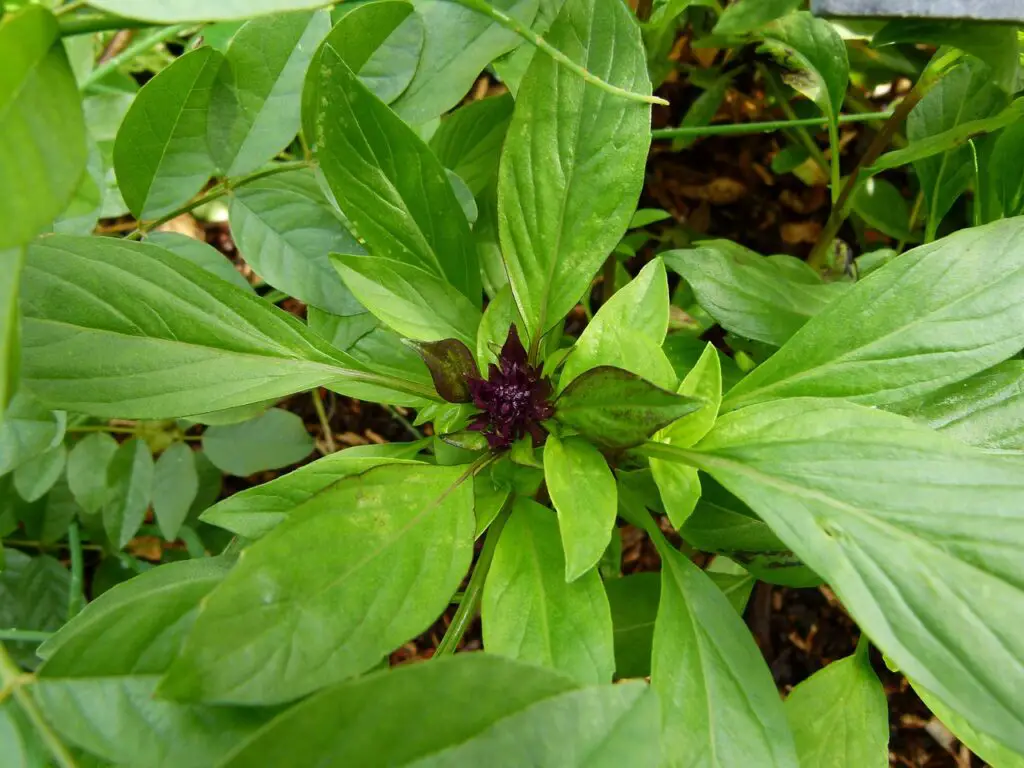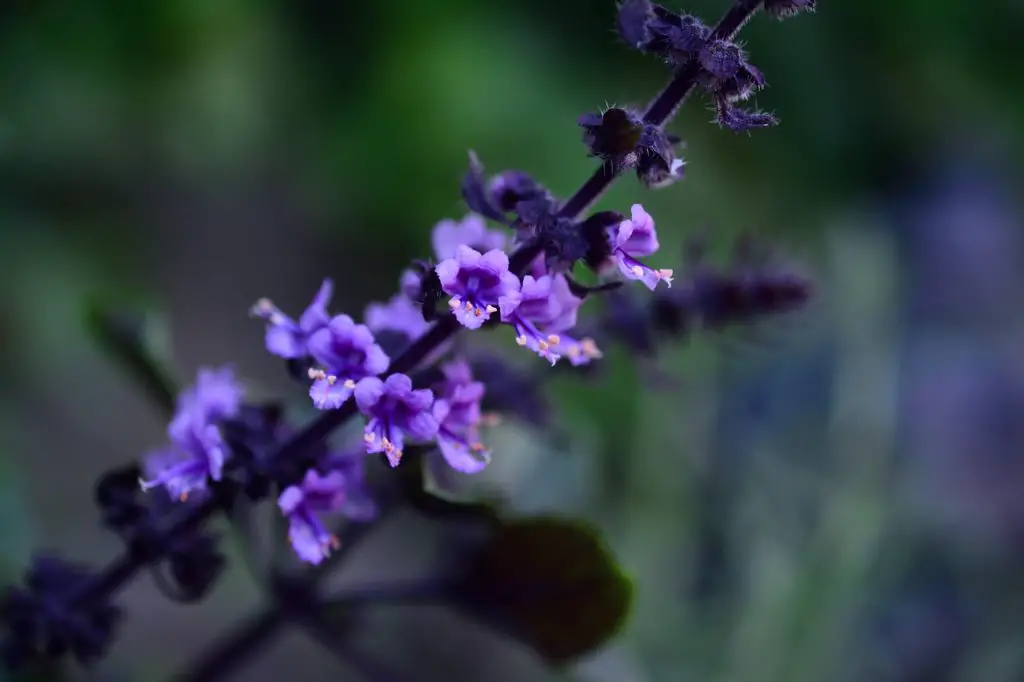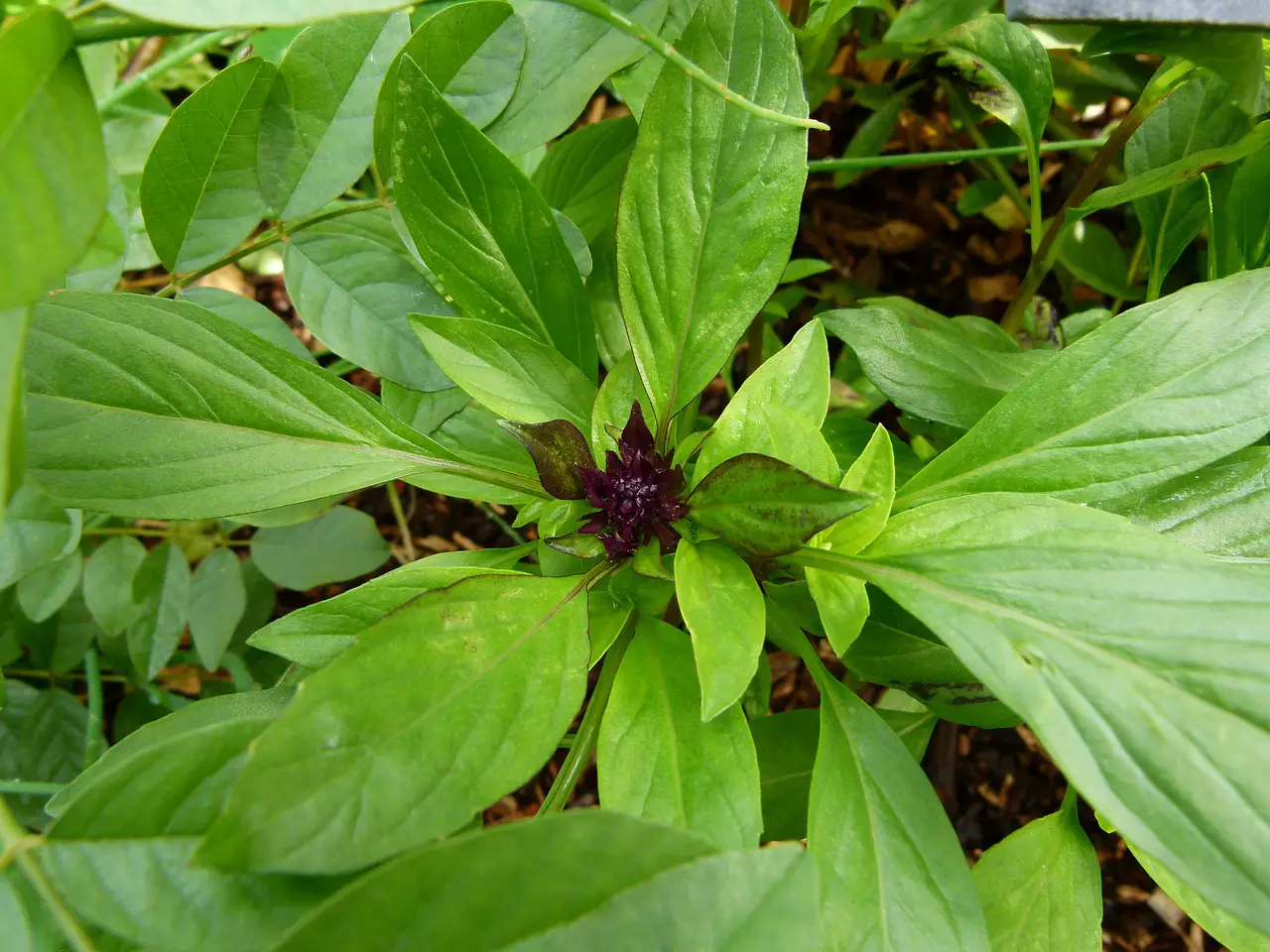
Thai basil (Ocimum basilicum var. thyrsiflora) is a distinct variety with a licorice-like flavor and spicy undertones. Its shiny, deep green leaves are narrower and more pointed than those of sweet basil. Thai basil is commonly used in Southeast Asian cuisine, particularly in Thai dishes like stir-fries, curries, and soups. It adds a unique, aromatic flavor to dishes and is often used as a garnish for its fresh, vibrant appearance. Compared to its regular basil counterpart it differs a little in the way you go about cultivating it, which we will learn about in todays article.
Thai Basil Varieties
Thai sweet basil has a licorice-like flavor and is common in Thai cuisine. Thai holy basil, or Tulsi, has a peppery taste and is revered for its medicinal properties in Ayurvedic tradition.
Thai Sweet Basil
Thai sweet basil varieties offer a range of flavors and characteristics. Siam Queen, with strong licorice/anise notes, is a robust heirloom basil suitable for high cooking temperatures. Sweet Large Leaf, also featuring a pleasant licorice flavor, is another option. Cardinal, known for its sweeter notes, is popular among small market farmers. These Thai sweet basil varieties add unique flavors to culinary creations.
Thai Holy Basil
Thai Holy Basil, also known as Tulsi, is esteemed for its medicinal and culinary uses. Varieties like Holy Green Leaf Basil boast a spicy, clove-like flavor and a bushy growth habit. Krapao Red, distinguished by its dark red stems and purple flower stalks, offers a unique appearance and distinctive taste to dishes.
How To Grow Thai Basil Plant
To grow Thai basil, plant seeds or seedlings in well-drained soil under full sunlight. Keep soil consistently moist and provide adequate space for growth. Thai basil thrives in warm temperatures and can be harvested regularly for optimal flavor.
How To Grow Thai Basil Plants From Seed
To grow Thai basil from seeds, start by directly sowing them a quarter-inch deep in well-draining soil, spacing them about an inch apart. Ensure rows are spaced 18 inches apart for adequate growth room. Once seedlings emerge, thin them to 8-12 inches apart to promote airflow and prevent overcrowding. Keep the soil consistently moist for optimal germination and growth. Alternatively, start Thai basil indoors in flats or trays about six weeks before the last frost date, then gradually acclimate seedlings to outdoor conditions before transplanting them.
Planting Thai Basil Indoors
Planting Thai basil indoors allows for year-round cultivation. Begin by selecting a container with drainage holes and filling it with well-draining soil. Sow Thai basil seeds or transplant seedlings into the container, ensuring they’re spaced properly. Place the container in a sunny location and water regularly, allowing the soil to dry slightly between waterings. With proper care, Thai basil thrives indoors, providing fresh herbs for culinary use.
Propagating Thai Basil Plants
Propagating Thai basil plants is simple and rewarding. Start by selecting healthy stems from an existing plant. Trim the stems just below a node, where a leaf meets the stem. Remove any lower leaves to expose the node. Place the stems in a glass of water or potting mix, ensuring the node is submerged. Within a few weeks, roots will develop, and you can transplant the new plants into soil for continued growth.

Thai Basil Plant Care
For optimal Thai basil care, ensure it receives at least six hours of sunlight daily. Keep the soil consistently moist but not waterlogged, and provide well-draining soil. Regularly pinch off flowers to encourage leaf growth and fertilize lightly every few weeks during the growing season.
Light
Thai basil thrives in full sunlight, receiving at least six hours daily, but can tolerate partial shade. Consider placing it near a south-facing window or under grow lights to ensure optimal light exposure.
Soil
Opt for well-draining, loamy soil with a slightly acidic to neutral pH. A mix of garden soil and compost works well. Ensure good drainage to prevent waterlogging, which can lead to root rot.
Water
Keep the soil consistently moist, but avoid overwatering, which can cause root rot. Water when the top inch of soil feels dry to the touch. Adjust watering frequency based on environmental conditions and the plant’s needs.
Temperature
Thai basil prefers temperatures between 70-90°F (21-32°C). Protect it from extreme temperatures, as frost can damage or kill the plant. Consider providing a sheltered location or bringing potted plants indoors during cold spells.
Harvesting Thai Basil
To prolong the harvest of Thai basil, wait until the plants reach about 10 inches tall and have multiple branching stems. When harvesting, cut stems or pinch off sections of leaves down to a growth node to promote branching and bushier growth. This also prevents premature flowering and seed production, ensuring a longer harvest season of fresh and flavorful Thai basil leaves.
Pruning Thai Basil
Once a young Thai basil plant has developed six to eight sets of leaves, prune the top set of leaves to promote branching and denser growth. Repeat this process on subsequent branches as the plant matures. Regular pruning not only encourages bushier growth but also stimulates the production of fresh leaves, which can be harvested for culinary use, ensuring a continuous supply of flavorful Thai basil.
Thai Basil Uses
After harvesting Thai basil, there are numerous ways to utilize it. Infuse it with vinegar or oil, flavor Pho with mint and chilies, make tea, or pair it with chicken, pork, or beef dishes. Recipes online feature Thai basil beer and Thai basil pesto with peanuts, rice vinegar, fish sauce, and sesame oil. Thai basil can be frozen in ice cube trays for up to two months or used for aromatherapy by bruising the leaves and inhaling their aroma, or applying them to the eyes and forehead for relaxation.
Common Pests & Plant Diseases
Protect Thai basil from common pests such as aphids, slugs, and Japanese beetles. Handpick Japanese beetles and submerge them in soapy water. Use insecticidal soap for aphids and diatomaceous earth or slug baits for slugs. Prevent diseases like fusarium wilt and bacterial leaf spot by watering the soil directly to keep foliage dry. This proactive approach ensures healthy Thai basil plants.
FAQ
When To Plant Thai Basil
Plant Thai basil outdoors after the last frost date, when temperatures remain consistently above 50°F (10°C). For indoor planting, start seeds six weeks before the last frost date and transplant seedlings after hardening them off gradually.
What Can I Plant With Thai Basil
Thai basil pairs well with tomatoes, peppers, eggplants, and cucumbers in the garden. In companion planting, it also benefits from being planted near aromatic herbs like oregano, thyme, and sage, which can help repel pests.
